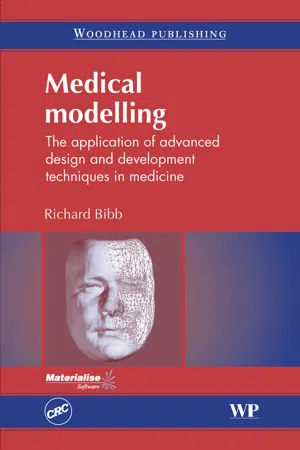
Medical Modelling
The Application of Advanced Design and Development Techniques in Medicine
- 310 pages
- English
- ePUB (mobile friendly)
- Available on iOS & Android
Medical Modelling
The Application of Advanced Design and Development Techniques in Medicine
About This Book
Research into medical modelling and the application of design and product development technologies in medicine and surgery requires a multidisciplinary approach. Designed to be accessible to all disciplines, with medical and technical terms explained as clearly and simply as possible, Medical modelling provides a genuinely useful text to help the broadest possible range of professionals to understand not only the technologies, techniques and methods, but also what is required to apply them in medical treatments.Medical modelling describes steps in the process from acquisition of medical scan data, transfer and translation of data formats, methods of utilising the data and finally using the information to produce physical models using rapid prototyping techniques for use in surgery or prosthetic rehabilitation. Technologies are fully described, highlighting their key characteristics, advantages and disadvantages. A series of case studies illustrates a broad range of medical applications. These case studies are taken from the collective experience of the National Centre for Product Design & Development Research, Medical Applications Group and their clinical partners, and have been chosen to reflect the widest possible variety of techniques used. Future developments in technology and applications in this dynamic and fast-moving field are also considered.This book will appeal to the wide variety of professionals who undertake collaborative research, development and treatment of human physical conditions using advanced computer-aided design and manufacturing techniques and technologies, including medical and clinical engineers and physicists, clinical technologists, rehabilitation engineers, design engineers in medical device design and manufacture, consultant surgeons and specialists in, for example, orthopaedics, orthodontics, and prosthetics.
- A comprehensive review of design and development technologies in medicine
- Designed to be accessible to all disciplines, with medical and technical terms explained as clearly and simply as possible
- Includes a series of case studies
Frequently asked questions
Information
Introduction
Publisher Summary
1.1 Background
Medical imaging for rapid prototyping
Select the optimal modality
Set appropriate protocols
Scan the patient
Export data media and format
Export the data from the scanner in an appropriate format
Transfer it to the RP laboratory
Working with medical scan data
Isolate data relating to the tissues or organs to be modelled
Save and transfer the data in the correct format for the RP process to be used
Physical reproduction – rapid prototyping technologies
Building the model
Cleaning, finishing or sterilising as required
Deliver the model to the clinician
1.2 The human form
Table of contents
- Cover image
- Title page
- Table of Contents
- Related titles:
- Copyright
- Preface
- Acknowledgements
- Chapter 1: Introduction
- Chapter 2: Medical imaging for rapid prototyping
- Chapter 3: Export data format and media
- Chapter 4: Working with medical scan data
- Chapter 5: Physical reproduction – rapid prototyping technologies
- Chapter 6: Case studies
- Chapter 7: Future developments
- Glossary and explanatory notes
- Bibliography
- Index